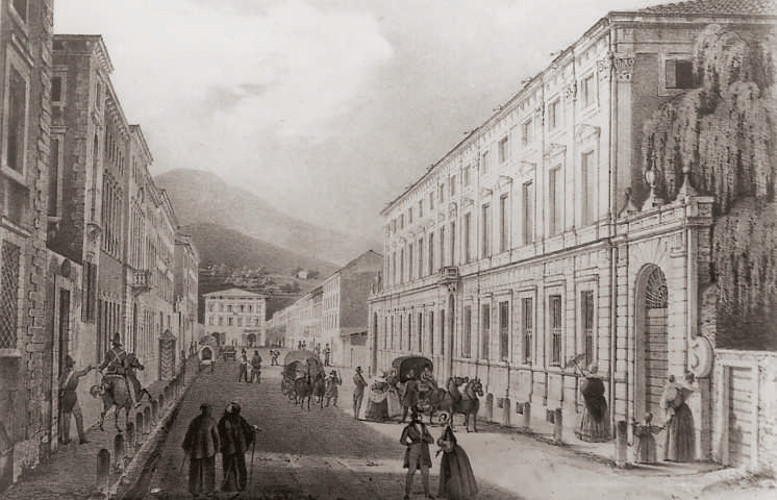Display board 10
ARTISTIC ENTERPRISES AND CULTURAL FERMENT
The 150 years between 1700 and 1850 were the most favourable and fertile in the history of Rovereto, characterized by an extraordinary economic development, a big population increase, a radical transformation of the town's structure and significant cultural renewal. During these years Rovereto changed from a country town to an industrial, mercantile city. The exceptional economic success, particularly tied to the development of the silk industry, permitted a notable accumulation of wealth and spurred the more well-off citizens to travel further away, not only for commercial reasons, but also for their self-improvement. Many found the occasion for cultural enlightenment in the big cities in Germany and Italy and learned the sciences, the etiquette and the taste for elegant furnishings and beautiful architecture. The rapidly accumulated wealth was then invested in building luxurious palaces and splendid suburban villas, to show off their acquired prestige.
The amazing economic growth was accompanied not only by building and artistic endeavours which changed the face of the city, but also by the recognition of a civil society composed of aristocrats and rich middle-class businessmen who made culture and intellectual life their strong point. New schools were built, music chapels funded, a delightful theatre created, the first public and private libraries established and the first newspapers founded. This ferment was crowned in 1750 by the inauguration of the Academy of the "Agiati", a circle of intellectuals which attracted leading exponents of local culture. In this context intellectuals like Girolamo Tartarotti, Clementino Vannetti, Clemente Baroni, Ambrogio and Antonio Rosmini emerged and operated.
THE DECLINE OF THE ART OF SILK MAKING
The businessmen of Rovereto had little inclination for risk, had quite limited capital and made no use of bank loans. At the first prolonged difficulty on the market, the entire sector fell into a crisis. This was evident during the Napoleonic period, when, between 1806 and 1811, the number of workers in silk manufacturing in the Rovereto District dropped by over 56%.
It is true that after this decline there was a period of new development partly due to the introduction of steam engines, but the productive and commercial equilibrium of the C 19th was by now very different from that of the C 18th. Thanks to new trade routes, enabled by the cutting of the Suez canal, Asian silks appeared on the main European marketplaces, at lower prices. A further blow to the Rovereto industries came from the French silk makers of Lyon, competition notably reinforced by sizeable public contributions.
From 1855 in Vallagarina the arrival of the pebrine, a disease affecting the silkworm, brought a slow but unrelenting process of decline in the silk industry which soon became irreversibile. The pebrine had disastrous effects on the sericulture which consequently lacked raw material. This dramatic crisis, together with certain unfavourable customs duties on silk products imposed by the Viennese government, led to the disappearance of almost all silk production by the end of the C 19th. The last throwing mill in Rovereto, run by the Bettini family, closed down in 1912.
At the same time the reeling mills also closed. The only places to remain open were the "galleys", that is the warehouses where the silkworms were suffocated and stored to be sold on Italian and foreign markets.
